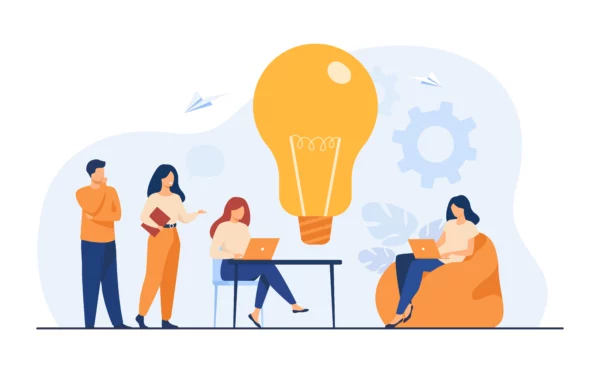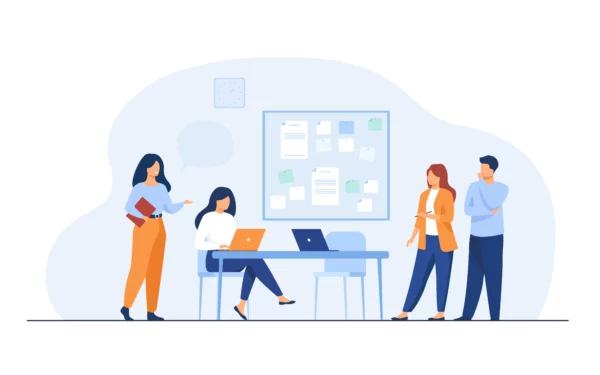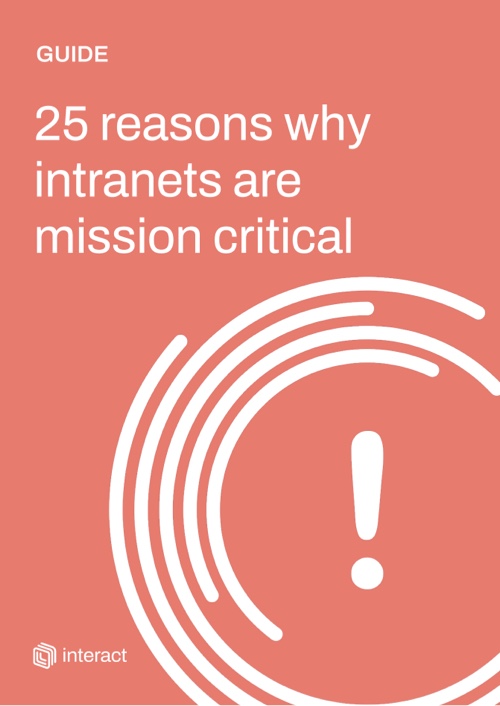What are the digital workplace trends enterprises need to be aware of in 2024 and beyond? Discover the upcoming trends across workplace technology, internal communications, HR, and leadership categories to prepare your organization for the future.
The rise of the digital workplace has represented a dynamic shift in how organizations operate and communicate. It is a fast-changing space, however, so to remain competitive and innovative, enterprises must understand emerging digital workplace trends and embrace the transformative nature of the powerful technologies at their disposal. This isn’t merely a choice; it’s a necessity in the digital age.
This article serves as a compass, guiding enterprises through the labyrinth of digital workplace trends that are emerging or already growing, and which are set to define the years ahead.
By staying ahead of the curve and leveraging these trends and technologies effectively, organizations can flourish—ensuring continued relevance in rapidly changing times.
Jump to:
Digital workplace trends 2024: Workplace technology

Embracing artificial intelligence and machine learning
Within the past year, the growth of AI in consumer-facing technologies has created a tipping point that has moved AI from science fiction to everyday fact.
Driven by AI and machine learning (ML), our workplaces are changing daily too. Gartner predicts that by 2025, 75% of large enterprises will leverage AI in at least one business function.
AI and ML offer the potential to improve productivity by automating tasks, personalizing the employee experience, and enhancing decision-making processes. To remain at the front of these wholesale changes, organizations need to have a sense of why and how they will use artificial intelligence, and then craft a clear strategy for integrating AI-led tools into the digital workplace.
The need for workplace usage and implementation strategies is perhaps one of the most underexplored areas of these new technologies so far. How should employees use AI in their everyday work? Will they need to optimize technology that already exists in their tech stack to accommodate these new additions? How might your InfoSec processes be compromised by people inputting customer data into large language training models?
Companies should expect to develop an AI usage policy by the end of 2024 if one isn’t already in place.
Having a robust strategy will help employees to be clear and protect organizations from the potential dangers inherent to sharing sensitive data. As we move forward, it’s clear that AI and ML are integral to the future of work—understanding how they should be used is critical.
An intranet can help solve your organization’s toughest challenges
The low-code/no-code future
Low-code/no-code platforms have ushered in a new era where employees can design and launch applications with less dependency on specialist technologists or a deep background in code.
One popular example of a low-code/no-code platform is Zapier, a platform that allows you to connect different apps and services together to create workflows and automation. This can be incredibly useful for marketers, who often need to manage tasks across multiple platforms.
A marketer could use Zapier to create a workflow that automatically sends a welcome email to new subscribers or posts new blog alerts on social media. They could also use Zapier to automate tasks such as lead generation, customer relationship management (CRM), and email marketing, all without needing to code anything.
In some quarters this trend is democratizing app development and empowering employees to address their unique challenges. According to Gartner’s projections, by 2024, 60% of applications will be constructed using low-code/no-code platforms.
However, allowing every employee to craft their own applications can lead to operational inefficiencies and unwanted tech bloat. As with intranet software, building your own software typically results in long delays and cost overruns for a project. In this sense, buying rather than building remains the preferred channel for most.
LCNC can have value for simple tasks or workflows, however, and some organizations are instituting citizen developer programs designed to empower individuals within the company to create custom solutions.
Despite the optimism in some quarters, LCNC needs to be tightly controlled to stop the unwanted explosion of ill-conceived software cluttering up your digital workplace.
The rise of the metaverse as a new digital reality
The metaverse is an evolving virtual world that promises to reshape our approach to work and leisure. Although it’s still in its developmental stage, it presents an exciting frontier for transformation, with some estimates predicting that by 2026, 25% of people will allocate at least one hour each day to activities within the metaverse. This will include work, shopping, education, and entertainment.
This emerging digital realm is an interconnected universe where people can interact, socialize, work, and play in a virtual environment and carries the potential to revolutionize how people work: giving rise to more convincing virtual workplaces, virtual meetings, and diverse training and development opportunities. It represents a new frontier where businesses can reach global audiences, create immersive brand experiences, and explore innovative ways to connect with customers and partners.
In light of these possibilities, enterprises will be proactively exploring how they can harness the metaverse because the successful implementation may help to cement some of the cracks in company culture and communication that have arisen during the shift from in-person to remote and hybrid models of work.
The initial success of the metaverse will depend on the cost and availability of hardware. In the longer term, however, use cases will include virtual onboarding for remote workers, expanded access to education and training, and a new level of innovative virtual communication.
A new focus on developer experience (DevX)
As with customer experience (CX) and employee experience (EX), developer experience (DevX) is the sum of interactions developers have with different tools, platforms, processes, and people.
A good DevX can help enterprises to attract and retain top engineering talent, and to deliver products and services faster and more efficiently.
Enterprises that want to be forerunners in DevX must provide current and prospective developers with the tools and platforms they need to be productive and successful. This includes prioritizing investment in cloud-based development environments, value stream management platforms (integrated platforms that enable the planning and management of digital delivery), and other DevX tools.
Crucially, 2024 will see an additional focus on communication, with more enterprises encouraging cross-departmental collaboration and ongoing learning. While much of this will invoke new workplace technologies, in many cases good DevX will revolve around the same pivots as CX and EX; namely, connecting people and teams through internal comms, HR best practices, and people-centric team processes.
With the labor market for talented developers remaining competitive in 2024 and beyond, large enterprises that rely on technologists are considering people processes as well as their technological provision.
An intranet can help solve your organization’s toughest challenges
The cloud is ubiquitous
“Pervasive cloud” refers to the increasing use of cloud computing across all aspects of an enterprise. This includes discarding on-premise hardware such as servers in favor of cloud-based applications, infrastructure, and platforms. These cloud applications enable security and scalability of data in everything from employee information and SaaS intranet software to customer-facing applications.
Just how pervasive is the cloud? The most recent research suggests that approximately 60% of corporate data was stored in the cloud in 2022; doubling the figure of 30% in 2015.
For the next year and beyond, experts predict that cloud momentum will continue and that “almost two-thirds (65.9%) of spending on application software will be directed toward cloud technologies in 2025, up from 57.7% in 2022.”
To enhance company performance through pervasive cloud utilization in 2024, organizations will be migrating even more applications and data to cloud-based services to unlock the advantages of scalability, flexibility, and cost-efficiency.
In the world of intranet software, although the cloud is now standard for many if not most organizations, we expect to see continued movement of businesses away from legacy, on-premises solutions. Anyone planning on such a migration will need to look carefully at their existing tech stack and the availability of digital workplace integrations with an intranet platform.
Digital workplace trends 2024: Internal communications

Manager-focused employee engagement
According to Gallup, less than a quarter of global workers are actively engaged, while 51% are actively seeking another job. This disengagement carries a hefty cost to the global economy, estimated at $8.8 trillion.
In 2024, it’s likely that efforts to improve these poor results will concentrate on specific workforce segments with significant influence. Providing people managers with more information and resources will become a key strategy to boost employee engagement.
Gallup emphasizes that 70% of team engagement hinges on the manager, making them pivotal in addressing engagement issues. Initiatives should focus on listening to identify the support managers require, followed by developing resources to meet those needs. Forward-thinking enterprises recognizing the importance of engaged managers should invest in creating manager hubs, providing access to shared knowledge, resources, and feedback loops.
Hyper-personalized employee communication
Organizations are increasingly using data and automation to personalize communication for each employee. This includes tailoring messages to their interests, needs, and roles.
For example, within the same company, a US employee in sales requires different content and communications than a UK employee in engineering. The same applies to employees who move between offices, retail stores, or geographic locations; they all need unique resources.
While this kind of personalization was possible in the past through labor-intensive manual work, automation is making it efficient and scalable.
One effective method for delivering hyper-personalized communications is through geofencing built into intranet software. Combined with a multi-factor permission environment, geofencing is another layer that enables communicators to build unprecedently granular employee audiences from roles, locations, departments, and more.
This allows even small teams of communicators to use location intelligence to welcome employees to workplaces, reduce digital noise, and surface the content and communications relevant to their specific role and precise location.
An intranet can help solve your organization’s toughest challenges
Video-first communication
Video is becoming the preferred communication channel for many employees. According to a report by Ragan, 75% of employees exhibit a greater inclination toward video content compared to consuming traditional text-based communications.
The benefits of video go beyond just enhanced engagement; it also facilitates quicker information processing for employees. HubSpot’s findings indicate that 90% of the data that reaches our brains is in visual form, and we can process visual content a staggering 60,000 times faster than text.
This surge in the adoption of video extends across various organizational functions, with video being harnessed for a multitude of purposes. These include conducting town hall meetings, team gatherings, training and development sessions, and initiatives geared toward boosting employee engagement.
AI-based video creation software looks set to benefit in 2024.
AI for internal comms—the good, the bad, and the inauthentic
We highlighted the rise of AI-powered technologies in the workplace trends section, but internal communication is a specific area of the digital workplace where everyday tasks are beginning to be enhanced by AI.
For example, Interact AI provides communicators and intranet content creators with many options to improve the quality and creation of comms and intranet content. This includes a generative AI that can produce, improve, simplify, shorten, or expand written communications and visual imagery based on simple prompts.
This kind of tool broadens the scope of who is able to communicate (giving more employees the skills of expert communicators) and makes work faster for time-pressed professional communicators through sentiment analysis, non-inclusive language detection, and auto-creation of more digestible content (e.g., simplifying complex policies into FAQs), for instance.
As ever with conversations around AI, there is a shadow hanging over its appearance. Namely, how should enterprises and their teams use AI within the workplace if they want to retain a people-centered approach? After all, if everyone solely creates comms and content written with a computer, doesn’t that devalue human relationships?
This has become a pressing question because the shift to hybrid working has been mirrored by an increase in less formal kinds of communication. As we see inside the (blurred) homes and workspaces of our coworkers and business leaders, we get to see more about them in different environments, which increases our sense of them as individuals.
Content coming from these people needs to be relatable and genuine, and an over-reliance on AI statements that strip them of personality or humanity may undermine any closeness people now expect.
To navigate this, communicators should emphasize authenticity, striking a careful balance between AI-generated messaging and organic human-generated content. It’s crucial for internal communication teams to define where they will leverage generative AI and where human input is indispensable.
Generative AI features are becoming commonplace already, but we expect to see them evolve even further in the next twelve months. Our tip for anyone looking to replace a communications platform is to ask about the vendor’s product roadmap in order to understand how they view AI as helping to promote better internal communication.
The email newsletter renaissance
Despite the growth of instant messaging channels such as Teams and Slack, email remains a powerful tool for internal communications.
In fact, employee email newsletters appear to be increasing in popularity, with 73% of employees stating that internal newsletters are an important source of company news and information in one Ragan survey.
One of the problems stymieing the use of email for internal communications, however, has been the myriad of different platforms. Adding yet another third-party solution to your comms channels can encourage overspending and more tech bloat. Additionally, some of the marketing-specific email solutions are not built for the specific needs of organizations.
Interact solves this challenge by offering multiple options for internal emails within an intranet platform. This includes update notifications, automated content roundups, and dedicated newsletters. Having a fully integrated communication system rather than multiple options is something communicators will rely on more in the near future.
An intranet can help solve your organization’s toughest challenges
Digital workplace trends 2024: Human resources

Mental health becoming the number one concern
According to Ipsos, mental health is now the top health concern for people globally. While employee wellbeing is already a concern for most organizations, mental health provision will be an area of greater focus in 2024 and beyond.
No matter how much effort employers put into helping people strike a healthy work-life balance, work can be stressful and demanding. A stressful employee experience can exacerbate poor mental health, and, in turn, poor mental health can amplify problems at work.
Proactive measures that HR teams can take to support mental health include creating a culture of awareness and acceptance that diminishes the stigma of speaking openly and asking for support; establishing employee assistance programs and providing self-serve access to mental health resources; and creating a supportive work environment where line managers set realistic expectations, encourage employees to take breaks, and provide opportunities for employees to connect with each other.
The next ‘Great’ thing: The Great Stay
In contrast to the Great Resignation, which saw record numbers of employees leaving their jobs in search of new opportunities, the Great Stay describes the shift towards people not wanting to leave their jobs because of adverse economic conditions. This looks like it will be a dominant trend for human resources in 2024.
Although the idea of decreased employee turnover sounds largely positive, if employees merely stay with an organization because they feel stuck by external factors, it may lead to poorer performance and productivity. This suggests HR teams may need to increase their focus on performance management and employee listening in the coming months.
Measures that HR can take to counter the impacts of the Great Stay include conducting regular employee engagement surveys to identify areas where improvement is needed; reviewing benefits packages, career development opportunities, and flexible work arrangements; and freeing up time using automation and AI so they can focus on more strategic initiatives to improve employee satisfaction.
Digital workplace trends 2024: Leadership

Human-centered leadership
Human-first leadership has been on the rise since the pandemic. Now, as technology continues to automate more tasks, the human touch will become increasingly important.
In addition to their continued strategic focus, more leaders in 2024 will spend time (re)building relationships and creating a positive work environment.
To be a human-first leader requires empathy. Success means being able to put oneself in the shoes of people across the organization: to be genuine, authentic, and possibly even vulnerable. It’s not for everyone, but as technology, generations, and the nature of work (from in-person to flexible) all change, leadership itself is already taking on a different complexion for many.
An intranet can help solve your organization’s toughest challenges
Encouraging employees to choose the tech that works for them
Historically, organizations have wielded authority in determining which technologies employees are permitted to use, yet as the prevalence of adaptive technologies continues to grow, these tools offer the capacity to be customized and harnessed in diverse ways to augment and refine the working methods of individuals across various roles.
In some cases, it is now advantageous to grant employees some freedom to explore different solutions. This can improve employee satisfaction in many ways, such as by providing more autonomy and flexibility in their work. Leaders who embrace technology to empower their employees will see several benefits, including increased employee engagement and productivity.
Perhaps the greatest concern for IT leaders with this approach is the development of “shadow IT” networks, where people begin to operate across a mix of personal and professional tools (e.g., saving work-related documents in a personal Google Drive). More than ever, this will result in organizations needing to create and maintain single sources of truth that people can rely on for accurate information, not vast disaggregated spaces. A consolidated knowledge base and strong content governance will become more important.
Accepting and adapting to hybrid working
Although some employers have reinstated a full-time return to specific work locations following the pandemic, hybrid working is now far more common than it was before 2020. Gartner has predicted that 48% of employees will be working remotely at least part of the time by 2024.
To lead effectively in this environment, due consideration should be given to what this means for leadership communication and presence too. Utilizing a wider range of communication channels and formats will help strategic messages to be shared with people across a more dispersed footprint than before. From written work to quick vlogs, leaders may have to rely on (or become) content creators for an internal audience.
Priming your organization to become a model digital workplace in 2024
The digital workplace is a dynamic environment in a constant state of evolution. It requires enterprises to be agile and responsive to emerging technologies and trends, but also to take a strategic view of how all investments will cohere.
In this context, intranet software emerges as a critical tool for enterprises seeking to embrace and implement these digital workplace trends in an integrated way.
An effectively designed intranet serves as a central portal, offering employees convenient access to the myriad tools and resources essential for their work.
Regardless of what changes or emerges in 2024, the need for communication and collaboration will never go away.
An intranet can help solve your organization’s toughest challenges
All other images by pch.vector on Freepik.






